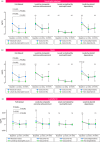Serum Neutrophil Biomarkers to Predict Crohn's Disease Progression and Infliximab Treatment Outcomes
- PMID: 39648597
- PMCID: PMC11975612
- DOI: 10.1002/ueg2.12712
Serum Neutrophil Biomarkers to Predict Crohn's Disease Progression and Infliximab Treatment Outcomes
Abstract
Background and aims: Predicting the treatment outcomes of biological therapies is an unmet need in Crohn's Disease. In this study, we explored the potential of serum neutrophil-related biomarkers to predict infliximab therapeutic results and disease progression in Crohn's Disease patients, over a 2-year period, in a real-world setting.
Methods: The study included 100 asymptomatic Crohn's Disease patients in the IFX maintenance phase from the prospective, observational, multicenter DIRECT study. Patients were categorized according to a composite outcome reflecting progression that included surgery, hospitalizations, new fistulae, abscess or stricture, and drug treatment escalation. Serum neutrophil elastase, lipocalin-2, lactoferrin, and resistin (non-neutrophil control) were analyzed via multiplex magnetic bead assays at multiple touchpoints. Fecal calprotectin was assessed by ELISA.
Results: Over up to 2 years of follow-up, serum biomarkers did not differentiate between the composite outcome groups, whereas fecal calprotectin was significantly higher in patients with worse outcomes. During the infliximab maintenance phase, there was a significant, sustained reduction of neutrophil elastase (p < 0.001), lipocalin-2 (p < 0.001), and lactoferrin (p < 0.001), but not of resistin, despite stable neutrophil levels. Correlations between NE and NGAL levels were strong (Pearson correlations 0.75-0.85); all other correlations were of small magnitude.
Conclusion: Our real-world data do not support using serum neutrophil elastase, lipocalin-2, or lactoferrin concentrations as predictors of treatment outcomes or disease evolution in infliximab -treated Crohn's Disease patients. On the other hand, the sustained decrease in biomarkers over time suggests that neutrophil stabilization might be an additional infliximab mechanism of action.
Keywords: Crohn's disease; fecal calprotectin; infliximab; lactoferrin’; lipocalin‐2; neutrophil elastase; resistin; serum neutrophil biomarkers.
© 2024 The Author(s). United European Gastroenterology Journal published by Wiley Periodicals LLC on behalf of United European Gastroenterology.
Conflict of interest statement
Author Fernando Magro served as speaker and received honoraria from Merck Sharp & Dohme, Abbvie, Vifor, Falk, Laboratórios Vitória, Ferring, Hospira and Biogen. All other authors declare no relevant competing interests.
Figures



References
-
- Arosa L., Camba‐Gómez M., and Conde‐Aranda J., “Neutrophils in Intestinal Inflammation: What We Know and What We Could Expect for the Near Future,” Gastrointestinal Disorders 2022 4, no. 4 (2022): 263–276, 10.3390/GIDISORD4040025. - DOI
Publication types
MeSH terms
Substances
Grants and funding
LinkOut - more resources
Full Text Sources
Medical
Miscellaneous

